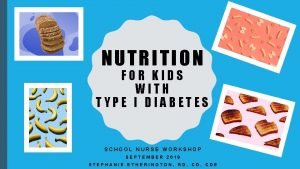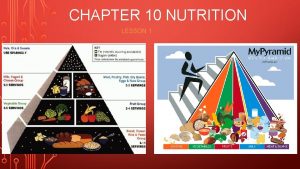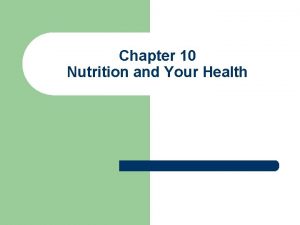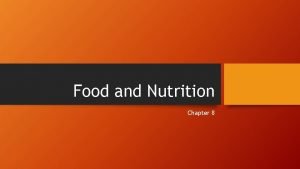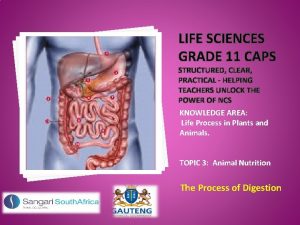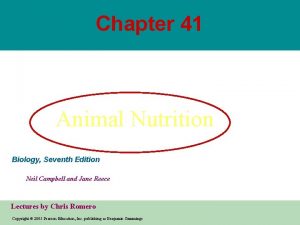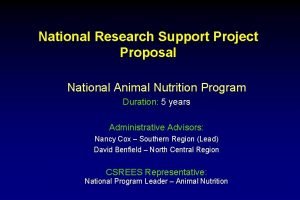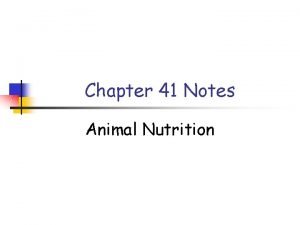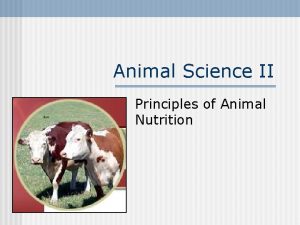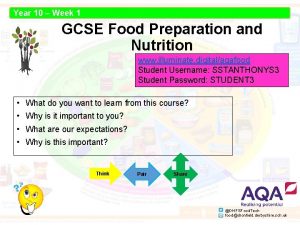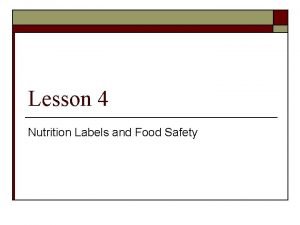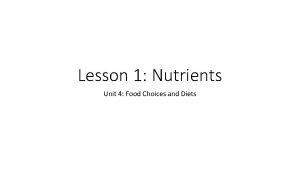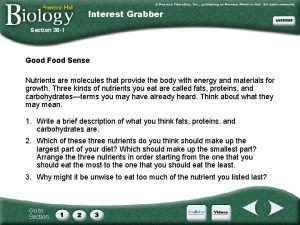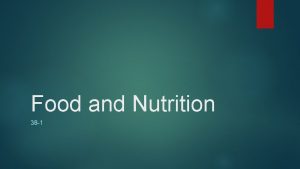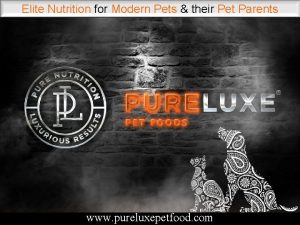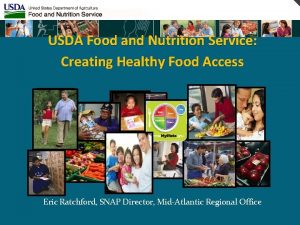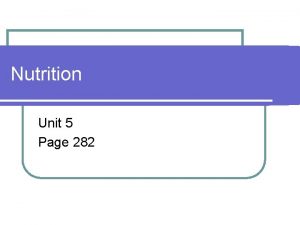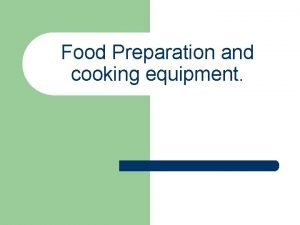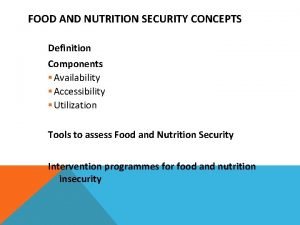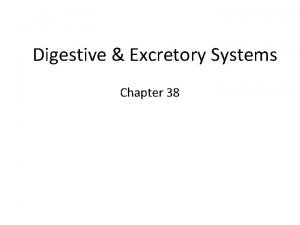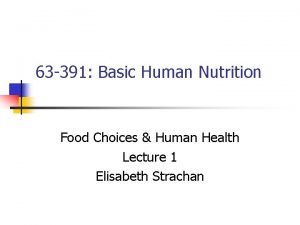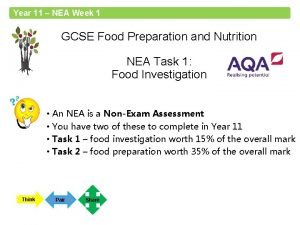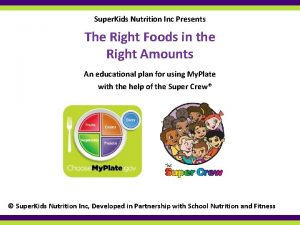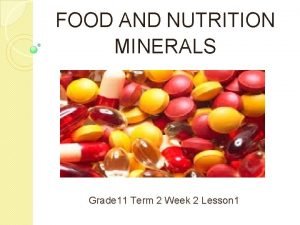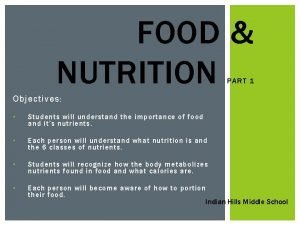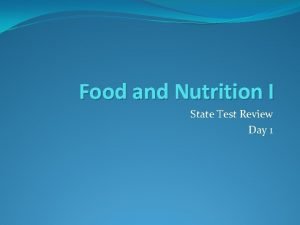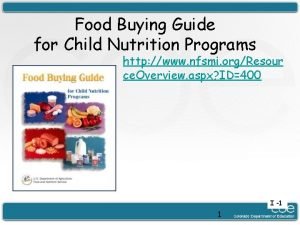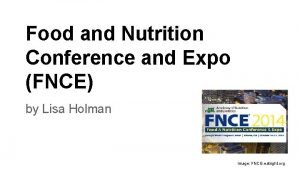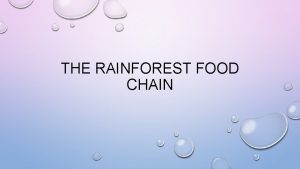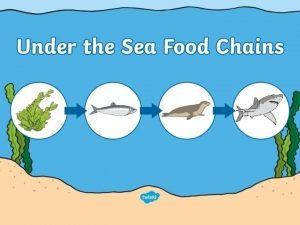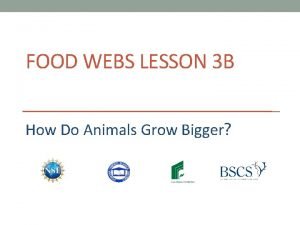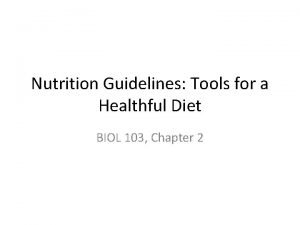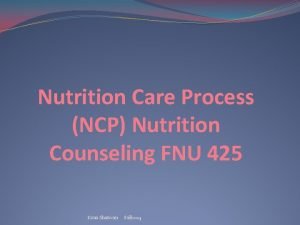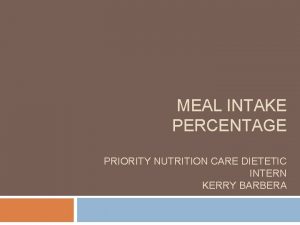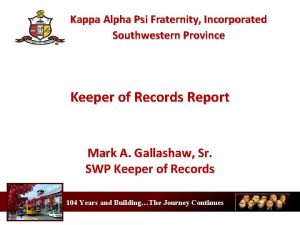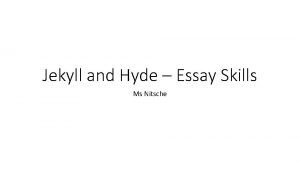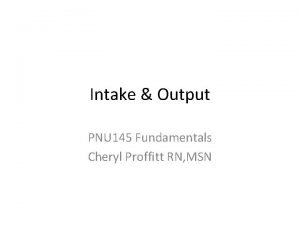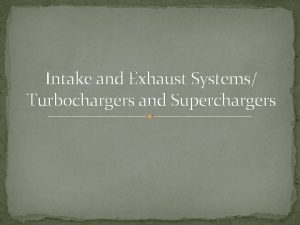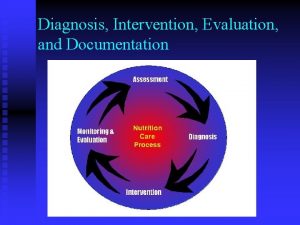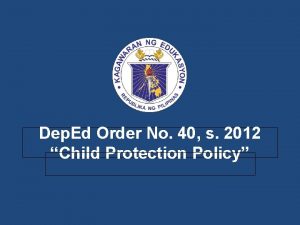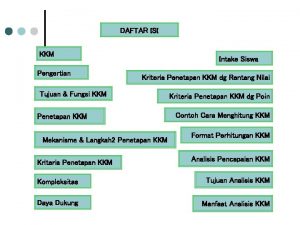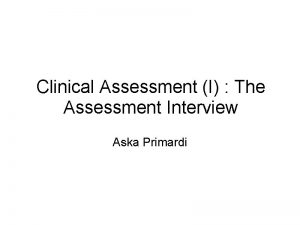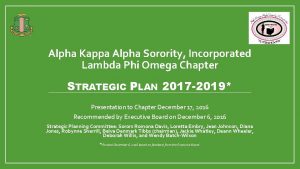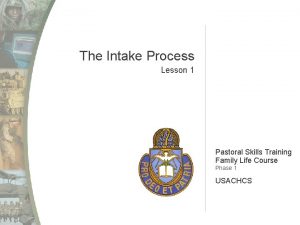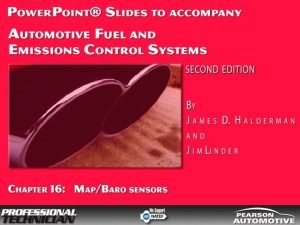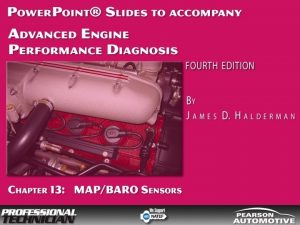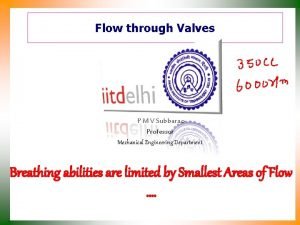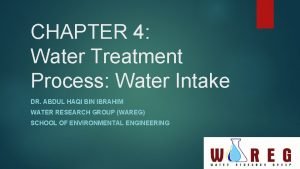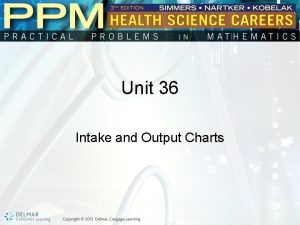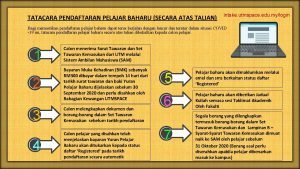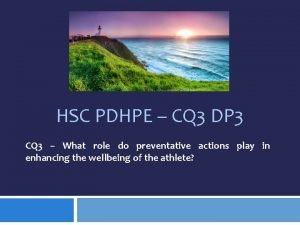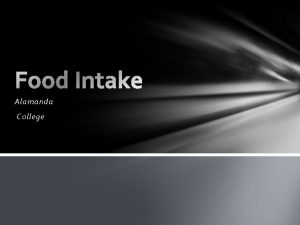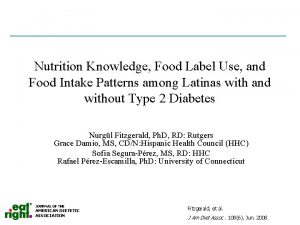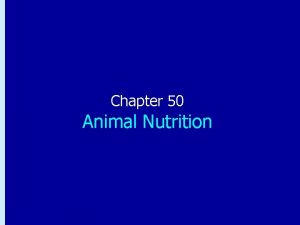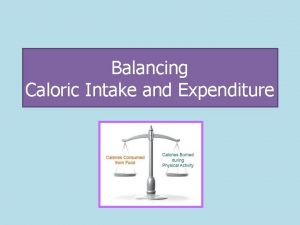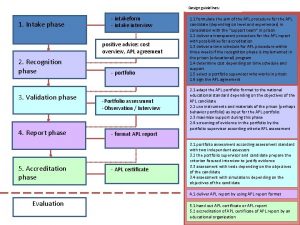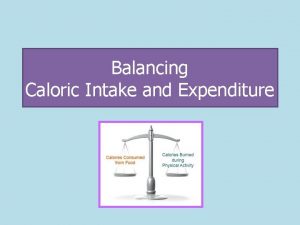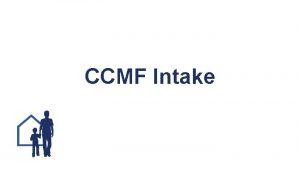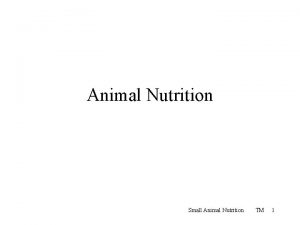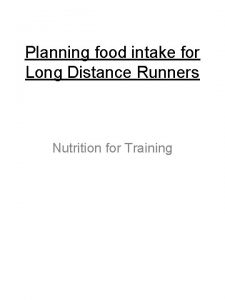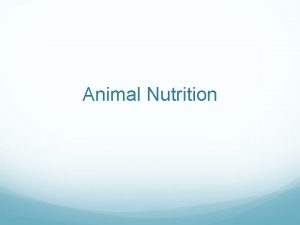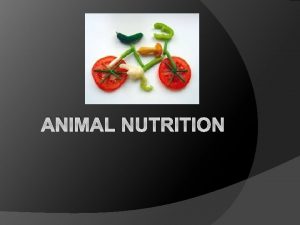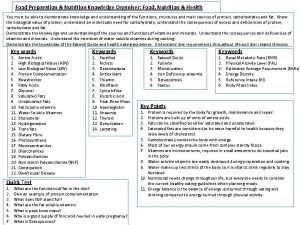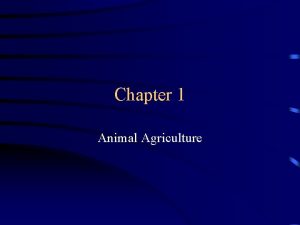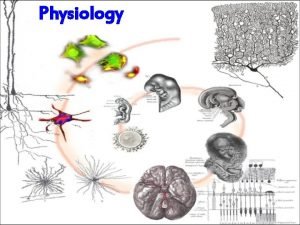Animal Nutrition Chapter 41 Nutrition Intake of food










































































- Slides: 74

Animal Nutrition Chapter 41

Nutrition § Intake of food from external environment § A balanced diet provides fuel for cellular work and the materials needed to construct organic molecules § Proper diet needed in order to maintain homeostasis (balanced internal environ. )

Nutrition § Nutrition satisfies three needs of animals: – fuel (chemical energy) for metabolism – the organic raw materials (carbon skeletons) – essential nutrients § substances animals can’t make themselves from any raw material –must obtain in food from environment

Energy (ATP) § Remember, cell resp. releases ATP by oxidizing food molecules –ATP powers basal or resting metabolism, as well as activity, and, in endothermic animals, temperature regulation

Biosynthesis and Energy Storage § More calories than needed to produce ATP, excess can be used for biosynthesis – growth in size, reproduction, or stored in energy depots § In humans, the liver and muscle cells store energy as glycogen (polymer of glucose units) § If glycogen stores are full and caloric intake still exceeds caloric needs, excess stored as fat – Basis for recent low-carb diet trend

Regulation of Glucose Levels (ie: blood sugar) § High Glucose (High Blood Sugar) – Pancreas secretes insulin § promotes glucose storage as glycogen in liver/muscles) § Low Glucose (Low Blood Sugar) – Pancreas secretes glucagon § promotes the breakdown of glycogen and release of glucose into blood

Glucose Regulation (Pancreas)

Undernourishment § When not receiving enough calories, the body breaks its energy stores down – Body first depends on liver stores, then muscle and fat glycogen – Average adult has enough fat stores for weeks of starvation § Severe malnutrition leads to loss of muscle mass and loss of brain proteins – Brain damage, death, or permanent disability possible

Overnourishment § Leads to obesity (excess fat stores) –Leads to serious health issues, especially cardiovascular disease and death § Excess carbs leads to storage as fat molecules § Hormones are involved in the regulation of fat storage

You are What you Eat § In addition to needing energy, you must take in certain molecules needed as raw materials (mostly C-skeletons) for important biomolecules § essential nutrients – must obtain from environment – Can’t make on their own – Species specific – Ex: vitamin C not important in all species, very important in humans

Malnourishment § Diet lacking in one or more essential nutrients § Even possible for an overnourished individual to be malnourished § Much more common in humans than undernourishment

Amino Acids § Animals require about 20 amino acids for protein synthesis § Can make about half from raw materials (provided enough nitrogen) § Essential Amino Acids Must be obtained in preassembled form § Protein deficiency – Missing one or more amino acids in diet – Most common form of malnourishment

Complete/Incomplete Proteins § Complete Proteins – Provide all essential amino acids – Meat, eggs, cheese (animal products) § Incomplete Proteins – Lacking one or more essential amino acids – Corn, rice, etc all lack an essential amino acid § Staples in 3 rd World Countries

Overcoming Incomplete Proteins § Eat a complementary mix of veggies that cover the essential amino acids § Eating the right mix of incomplete proteins is as effective as eating complete proteins

Fatty Acids § Most fatty acids can be synthesized § There a few essential fatty acids (usually unsaturated) § Deficiencies are rare

Vitamins § Required in relatively trace (minimal) amounts § However, deficiencies can have drastic effects § 13 vitamins essential to humans –water-soluble vitamins –fat-soluble vitamins

Water Soluble Vitamins

Fat Soluble Vitamins

Minerals § Simple inorganic nutrients § Usually required in small amounts § Ex: Ca+2 and PO 4 -3 required for bones § Ex: Iron needed for hemoglobin, cytochrome complex (ETC) § Na+, K+ and Cl- needed for osmotic balance and transport

Minerals

Types of Nutrition – Herbivores (gorillas, cows, hares) eat mainly autotrophs (plants, algae) – Carnivores (sharks, hawks, spiders, and snakes) eat other animals – Omnivores (humans) consume animal and plant or algal matter

Suspension Feeders § sift small food particles from the water § Ex: baleen whales, clams

Deposit Feeders (e. g. , earthworms) § Eat their way through dirt or sediments extract partially decayed organic material consumed along with the soil or sediments

Substrate Feeders § Live in or on their food source § Ex: Maggots consuming a decaying carcass § Ex: Leaf Miner (right) burrows through leaf

Fluid Feeders § Suck nutrient-rich fluids from a living host § Often considered parasites § Ex: Mosquitoes and leaches suck blood from animals § Ex: Aphids tap the phloem sap of plants § Ex: Hummingbirds and bees are good fluid feeders (nectar)

Bulk Feeders § Most animals eat relatively large portions of food when available § This is sort of a take it while you can get it approach to nutrition b/c food can be scarce

Ingestion Take Food In § Act of eating § First stage of food processing § Food molecules cannot be used “as-is” and must be digested in order for the cells to make use of them as nutrients

Digestion Break Food Down § Why is food digested? ? – Polymers in food molecules too large to pass into cells – Macromolecules in food are not exactly what makes up the animal eating them § However, animals all use common monomers to assemble macromolecules

Digestion § Break food down into small, absorbable molecules § Polysaccharides and disaccharides are split into simple sugars. § Fats are digested to glycerol and fatty acids. § Proteins are broken down into amino acids. § Nucleic acids are cleaved into nucleotides

Enzymatic Hydrolysis § Reverse process as dehydration synthesis § Enzymes are used to cleave polymers into monomers § Specific enzymes digest the specific classes of macromolecules § Chemical digestion (enzymes) is generally preceded by mechanical digestion (chewing, gizzard)

Absorption and Elimination § Useful nutrient molecules are absorbed and used by the animal § Molecules that have little use in the organism are eliminated as waste

Digestion § Specialized organs perform the various digestion of food molecules § Keeps organisms from digesting their own cells Intracellular Digestion § Food vacoules break down particles via hydrolytic enzymes § Sole digestion of many protists

Food Vacuole Digestion

Extracellular Digestion § Takes place outside of cells § Fungi release enzymes into the soil that digest their food before it enters them § Allows smaller single-celled organisms to consume larger food molecules than phagocytosis

Gastrovascular Cavities § Single opening digestive systems § Food enters mouth, is digested in GV cavity, and undigested material is eliminated back through the mouth § Cnidaria, flatworms

Alimentary Canals (complete digestive tube) § Mouth, digestive tube (stomach, gizzard, intestines), and anus § Runs in one direction, food processed differently in different compartments § Mouth Pharynx Esophagus Crop/Gizzard/Stomach (species dep. ) Intestines Anus

Alimentary Canals

Human Digestion – 5 to 10 seconds in esophagus – 2 to 6 hrs in the stomach being partially digested – 5 to 6 hrs in small intestine (final digestion and nutrient absorption) – 12 to 24 hours after consumption, undigested material eliminated through large intestine and anus

Human Digestive System

Levels of Organization § Cells are the basic functional unit § Cells Tissues Organ Systems Organism

Tissues § Epithelial tissue covers the surface of the body and lines the inside of organs § simple epithelium - single layer of cells; stratified epithelium - multiple tiers of cells § The shapes of cells: cuboidal (like dice) columnar (like bricks on end) squamous (flat like floor tiles)


Muscles § Many muscles are involved in digestion § Some are voluntarily controlled (skeletal muscle) and others are involuntarily controlled (smooth muscle) § Skeletal Striated, voluntary, found in muscles and other voluntarily controlled sphincters § Smooth Not striated, involuntary, peristalsis § Cardiac Found in the heart, involuntary


Oral Cavity (Mouth) § Begins physical (chewing) and chemical digestion of food § Salivary amylase breaks down starch § Enzyme released in response to food presence § Chewing increases surface area for chemical digestion § Saliva also lubricates food for passage through esophagus

Pharynx § Between the mouth and the esophagus § Epiglottis Flap of skin that keeps the bolus (food ball) from “going down the wrong pipe” § When swallowing, the epiglottis covers the trachea and diverts food into the esophagus

Epiglottis

Esophagus § Top muscles are voluntary (part of swallowing you control) § Involuntary series of muscle contractions (peristalsis) move food from mouth to stomach after it passes into esophagus from pharynx

Stomach § Chemical and mechanical digestion (involuntary) proceed in the stomach § Elastic walls and folds allow the stomach to churn about 2 L of food/liquid at a time § Secretes gastric juice (pepsin + HCl) that chemically digests

Gastric Juice – HCl provides acidic environment for pepsin and kills bacteria ingested with food § HCl converts pepsinogen (inactive) to pepsin (active) – Pepsin is an enzyme that hydrolyzes proteins – Chief cells secrete pepsin – Parietal cells secrete HCl


Stomach § Stomach lining replaced by mitosis every three days § Lining of mucus keeps the pepsin from digesting the stomach wall § H. pylori § Acid-resistant bacteria that causes human ulcers

Small Intestine § Food (now chyme) passes through the pyloric sphincter into the small intestine § Small intestine is about 6 m (20 feet) in length in adult humans § Most of the digestion and absorption occurs in the small intestine § Adapted to maximize absorptive surface area

§ First 25 cm of small intestine § Chyme mixed with digestive juices from the pancreas, liver, gall bladder, and gland cells of the intestinal wall § p. H becomes more basic than stomach was due to pancreatic secretions Duodenum

Bile § Produced by the liver § Stored in the gallbladder § Aid in the emulsification (digestion) and absorption of fats

Digestive Enzyme Specificity (location and substrate)

Starch Digestion § Begins in the mouth with salivary amylase § Continues in the small intestine with amylase. § Amylase breaks polysaccharides into disaccharides (sucrose and maltose) –Maltase and sucrase then break them into monomers of glucose and/or fructose for use in cellular respiration

Protein Digestion § Trypsin is the major enzyme that breaks down proteins in the duodenum § Proteins are broken down into their amiono acids § Other enzymes act upon the polypeptides produced by trypsin if trypsin doesn’t completely digest to amino acids

§ Trypsin is secreted as inactive trypsinogen by pancreas § Intestinal enzymes activate trypsin Protein Digestion

Nucleic Acid Digestion § First, nucleases break down DNA and RNA into nucleotides (Pi+sugar+base) § Other enzymes then break down the nucleotides into Pi, sugars, and nitrogenous bases for reassembly into new nucleotides

Fat Digestion § Fat does not get digested until the small intestine § Bile released by the gallbladder emulsifies the fats –Emulsification Separate fats into tiny droplets § Lipases then hydrolyzes the fats into fatty acids and glycerol

Small Intestine § Most of the digestion occurs in the duodenum § Jujenum and ileum function mainly as absorptive surfaces –Absorption of nutrients and water –Small intestine has approx. same surface area as a tennis court to increase absorption

Absorption § Folds and projections increase the SI surface area § Villi and microvilli are projections that increase SA § Lacteals –Networks of blood vessels (capillaries) that absorb nutrients across intestinal wall §Only 2 layers of cells separate lacteals from lumen of intestine

Absorption § Depending on the size and charge of the nutrient involved, absorption can either be passive or active § People eating a good diet absorb about 85% of the organic nutrients they consume § Cellulose (plant cell walls) is indigestible and becomes roughage of feces § Digestion is a very energetically and chemically efficient process

Hormones and Digestion § The sight, smell, or taste of food causes the brain to send a chemical signal to the digestive organs to prepare to digest § Hormones in the various organs cause the secretion of the necessary digestive juices

The Large Intestine (Colon) § Major function is reabsorption of water § b/t SI and LI, 90% of H 2 O reabsorbed § Peristalsis moves feces through the colon towards the rectum § Diarrhea Too little H 2 O reabsorbed § Constipation Too much H 2 O reabsorbed

Intestinal Bacteria § E coli is the main bacteria found in the intestine § Most of the bacteria live off of excess nutrients and release vitamins for us § Bacteria are also involved in the regulation of water reabsorption –This is why antibiotics can cause diarrhea

Feces § Feces contain the undigested materials being eliminated by the organism § They often contain a lot of cellulose and salts § They are stored in the rectum and eliminated through the anus § Two sphincters (one voluntary, one not) control defecation

Dentition § Teeth are adapted to the type of food the organisms consume § For example, horses have large flat teeth for grinding grasses while wolves have sharp teeth to tear at prey flesh § Humans show intermediate dentition because we have evolved as omnivores

Dentition

Length of Digestive System § Since vegetation has cell walls, herbivores have longer alimentary canals to allow for adequate nutrient extraction § Takes longer to extract nutrients from plants

Symbiosis § Animals that do not have enzymes to digest cellulose form relationships with bacteria that do have these enzymes –Ex: Horse § The bacteria break down the cellulose and the simpler sugars are absorbed by the animal

Ruminants § Deer, cattle, sheep § As the animal eats grasses, the grasses pass through structures (rumen, reticulum) where microorganisms digest cellulose § After being processed by microorganisms, the food passes through to be fully digested and absorbed

Ruminants
 Carbohydrates, proteins and fats chart pdf
Carbohydrates, proteins and fats chart pdf Chapter 10: nutrition for health lesson 1 answer key
Chapter 10: nutrition for health lesson 1 answer key Chapter 10 lesson 4 nutrition labels and food safety
Chapter 10 lesson 4 nutrition labels and food safety Chapter 8 food and nutrition
Chapter 8 food and nutrition Unit 2 food food food
Unit 2 food food food Food chain food chain food chain
Food chain food chain food chain Life science grade 11 animal nutrition
Life science grade 11 animal nutrition Teks anatomy and physiology
Teks anatomy and physiology Animal nutrition grade 11 practical
Animal nutrition grade 11 practical Animal nutrition 7th edition
Animal nutrition 7th edition Unit 26 animal anatomy physiology and nutrition
Unit 26 animal anatomy physiology and nutrition National animal nutrition program
National animal nutrition program Animal nutrition notes
Animal nutrition notes Principles of animal nutrition
Principles of animal nutrition Zeta phi beta pledging process
Zeta phi beta pledging process Animal vs plant cell venn diagram
Animal vs plant cell venn diagram Plant animal cell venn diagram
Plant animal cell venn diagram Animal rights vs animal welfare
Animal rights vs animal welfare Illuminate aqa food preparation and nutrition
Illuminate aqa food preparation and nutrition Lesson 4 nutrition labels and food safety
Lesson 4 nutrition labels and food safety Food and nutrition unit 4
Food and nutrition unit 4 38-2 the process of digestion
38-2 the process of digestion Food and nutrition unit 4
Food and nutrition unit 4 Section 38-1 food and nutrition
Section 38-1 food and nutrition Extreme elite nutrition dog food
Extreme elite nutrition dog food Usda food and nutrition service
Usda food and nutrition service Food and nutrition unit 5
Food and nutrition unit 5 10 labour saving devices and their uses
10 labour saving devices and their uses Define nutrition security
Define nutrition security Questions on digestive system
Questions on digestive system Dri vs rda
Dri vs rda Food nea
Food nea Food n nutrition
Food n nutrition Food and nutrition grade 11
Food and nutrition grade 11 Food nutrition
Food nutrition Endosperm of wheat
Endosperm of wheat Baby food buying guide
Baby food buying guide Food and nutrition expo
Food and nutrition expo Food chains of the tropical rainforest
Food chains of the tropical rainforest Food webs clipart
Food webs clipart Starfish food chain
Starfish food chain Draw and label food chain
Draw and label food chain What animal is on the top of the food chain
What animal is on the top of the food chain Project intake and prioritization
Project intake and prioritization Unesco institute for statistics
Unesco institute for statistics Recommended alcohol intake per day
Recommended alcohol intake per day Ul tolerable upper intake level
Ul tolerable upper intake level Excessive fat intake pes statement
Excessive fat intake pes statement Priority nutrition care
Priority nutrition care Demand management meaning
Demand management meaning Alpha kappa alpha membership intake process manual
Alpha kappa alpha membership intake process manual Shrank back with a hissing intake of breath analysis
Shrank back with a hissing intake of breath analysis Termination interview
Termination interview Intake output
Intake output Intake and exhaust systems
Intake and exhaust systems Intake vs input
Intake vs input Herstelondersteunende intake
Herstelondersteunende intake Dris
Dris Limited food acceptance pes statement
Limited food acceptance pes statement Deped order no. 40 s. 2012
Deped order no. 40 s. 2012 Kompleksitas siswa adalah
Kompleksitas siswa adalah Milady client intake form
Milady client intake form Intake-admission interview
Intake-admission interview Deped order no. 40 s. 2012 intake sheet
Deped order no. 40 s. 2012 intake sheet Alpha kappa alpha membership intake process manual
Alpha kappa alpha membership intake process manual Training intake process
Training intake process As the load on an engine increases the manifold
As the load on an engine increases the manifold A typical map compares the vacuum in the intake manifold to
A typical map compares the vacuum in the intake manifold to Intake flow
Intake flow Intake water treatment process
Intake water treatment process Counseling intake interview
Counseling intake interview Project intake process presentation
Project intake process presentation Intake and output chart example
Intake and output chart example Utmspace intake
Utmspace intake Acclimatisation pdhpe
Acclimatisation pdhpe
